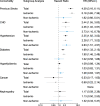Association of total pre-existing comorbidities with stroke risk: a large-scale community-based cohort study from China
- PMID: 34674693
- PMCID: PMC8529731
- DOI: 10.1186/s12889-021-12002-1
Association of total pre-existing comorbidities with stroke risk: a large-scale community-based cohort study from China
Abstract
Background: Comorbidities, any other coexisting diseases in patients with a particular index disease, are known to increase the mortality of a stroke. However, the association of pre-existing comorbidities with stroke risk has not been fully studied.
Methods: This study included 16,246 adults from a prospective community-based cohort with a baseline survey conducted in 2013 in China. Participants were followed up with hospitalization records and the Cause of Death Registry. The association of eight pre-existing comorbidities (coronary heart disease, hyperlipidemia, hypertension, diabetes, previous stroke, chronic obstructive pulmonary disease, nephropathy, and cancer) with stroke risk was analyzed using the Cox proportional hazard model in 2020.
Results: At a median follow-up of 5.5 years, a total of 449 participants (206 men and 243 women) developed a stroke. Four pre-existing comorbidities (hypertension, congenital heart disease, previous stroke, and diabetes) were independently and positively associated with the risk for all types of stroke. The adjusted hazard ratios for participants with only 1 and ≥ 2 pre-existing comorbidities compared with those without pre-existing conditions were 1.96 (95% CI: 1.44, 2.67; P < 0.001) and 2.87 (95% CI; 2.09, 3.94; P < 0.001) for total stroke, respectively. Moreover, male and female participants with a combination of increased age and a higher number of pre-existing comorbidities experienced the greatest risk of stroke.
Conclusions: The number of pre-existing comorbidities was independently associated with an increased risk of stroke. There was a synergic effect between increased age and a higher number of pre-existing comorbidities on stroke occurrence. Our novel findings emphasize the importance and potential application of pre-existing comorbidities as a risk indicator in stroke prevention.
Keywords: Cohort studies; Pre-existing comorbidity; Risk; Stroke.
© 2021. The Author(s).
Conflict of interest statement
The authors declare they have no conflicts of interest.
Figures


Similar articles
-
Association of pre-existing comorbidities with mortality and disease severity among 167,500 individuals with COVID-19 in Canada: A population-based cohort study.PLoS One. 2021 Oct 5;16(10):e0258154. doi: 10.1371/journal.pone.0258154. eCollection 2021. PLoS One. 2021. PMID: 34610047 Free PMC article.
-
Comorbidities and breast cancer survival: a report from the Shanghai Breast Cancer Survival Study.Breast Cancer Res Treat. 2013 May;139(1):227-35. doi: 10.1007/s10549-013-2521-2. Epub 2013 Apr 19. Breast Cancer Res Treat. 2013. PMID: 23605082 Free PMC article.
-
Asymptomatic hyperuricemia and incident stroke in elderly Chinese patients without comorbidities.Eur J Clin Nutr. 2019 Oct;73(10):1392-1402. doi: 10.1038/s41430-019-0405-1. Epub 2019 Feb 20. Eur J Clin Nutr. 2019. PMID: 30787471
-
The link of depression, untreated hypertension, and diabetes with mortality in postmenopausal women: A cohort study.Clin Exp Hypertens. 2021 Jan 2;43(1):1-6. doi: 10.1080/10641963.2020.1790584. Epub 2020 Jul 27. Clin Exp Hypertens. 2021. PMID: 32715792
-
Depression, stroke, and dementia in patients with myocardial infarction.Dan Med J. 2018 Apr;65(4):B5423. Dan Med J. 2018. PMID: 29619929 Review.
Cited by
-
National Trends, Risk Factors, and Outcomes of Acute In-Hospital Stroke Following Lung Transplantation in the United States: Analysis of the United Network for Organ Sharing Registry.Chest. 2023 Oct;164(4):939-951. doi: 10.1016/j.chest.2023.04.007. Epub 2023 Apr 11. Chest. 2023. PMID: 37054775 Free PMC article.
-
Combination of alpha-1 antitrypsin (A1AT) and anti-TNFα as a neuroprotective strategy in the early stages after ischemic stroke.J Cereb Blood Flow Metab. 2025 May 15:271678X251340234. doi: 10.1177/0271678X251340234. Online ahead of print. J Cereb Blood Flow Metab. 2025. PMID: 40370316 Free PMC article.
-
Management of ischaemic stroke survivors in primary care setting: the road to holistic care.Intern Emerg Med. 2024 Apr;19(3):609-618. doi: 10.1007/s11739-023-03445-y. Epub 2023 Oct 24. Intern Emerg Med. 2024. PMID: 37875703 Free PMC article. Review.
-
Investigating the impact of glycated hemoglobin levels on stroke severity in patients with acute ischemic stroke.Sci Rep. 2025 Apr 9;15(1):12114. doi: 10.1038/s41598-025-95305-2. Sci Rep. 2025. PMID: 40204797 Free PMC article.
-
Assessment of Knowledge and attitude towards Stroke among the UAE population during the COVID-19 pandemic: A cross-sectional study.F1000Res. 2023 Oct 13;12:322. doi: 10.12688/f1000research.129873.2. eCollection 2023. F1000Res. 2023. PMID: 37854872 Free PMC article.
References
-
- Virani SS, Alonso A, Benjamin EJ, Bittencourt MS, Callaway CW, Carson AP, Chamberlain AM, Chang AR, Cheng S, Delling FN, Djousse L, Elkind MSV, Ferguson JF, Fornage M, Khan SS, Kissela BM, Knutson KL, Kwan TW, Lackland DT, Lewis TT, Lichtman JH, Longenecker CT, Loop MS, Lutsey PL, Martin SS, Matsushita K, Moran AE, Mussolino ME, Perak AM, Rosamond WD, Roth GA, Sampson UKA, Satou GM, Schroeder EB, Shah SH, Shay CM, Spartano NL, Stokes A, Tirschwell DL, VanWagner L, Tsao CW, American Heart Association Council on Epidemiology and Prevention Statistics Committee and Stroke Statistics Subcommittee Heart disease and stroke Statistics-2020 update: a report from the American Heart Association. Circulation. 2020;141(9):e139–e596. doi: 10.1161/CIR.0000000000000757. - DOI - PubMed
-
- Wang W, Jiang B, Sun H, Ru X, Sun D, Wang L, Wang L, Jiang Y, Li Y, Wang Y, Chen Z, Wu S, Zhang Y, Wang D, Wang Y, Feigin VL, NESS-China Investigators Prevalence, incidence, and mortality of stroke in China: results from a Nationwide population-based survey of 480 687 adults. Circulation. 2017;135(8):759–771. doi: 10.1161/CIRCULATIONAHA.116.025250. - DOI - PubMed
Publication types
MeSH terms
LinkOut - more resources
Full Text Sources

